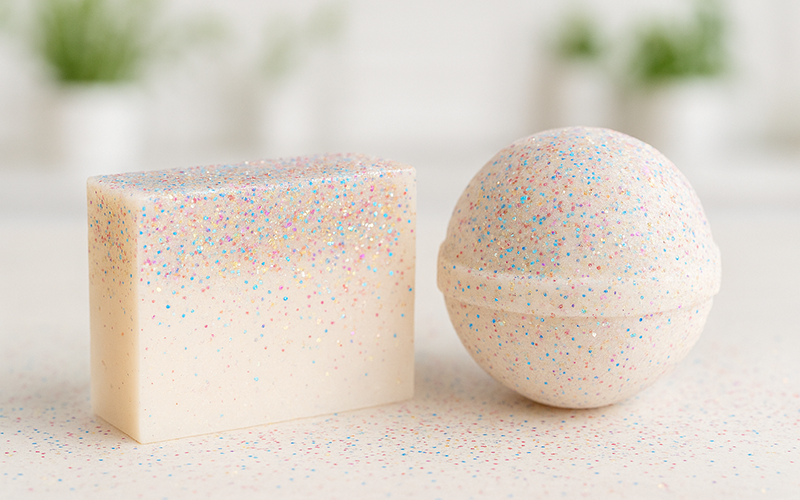For years, glitter has been a favorite in soap, bath bombs, and cosmetics — adding sparkle and fun. But if your sparkle comes from plastic glitter, there’s big news out of California: the state has just approved AB 823, legislation that will ban plastic glitter in personal care products, with the law set to take effect in 2029.
This new ban expands on earlier rules about microplastics and marks a significant change for soap and cosmetic makers, both inside and outside California, who sell to California residents.
What’s So Bad About Microbeads and Glitter?
Microplastics, including microbeads and glitter, don’t break down in the environment the way natural materials do. Instead, they wash down the drain and accumulate in rivers, lakes, and oceans.
Once in the water, they can be eaten by fish and other wildlife, making their way up the food chain and even into human diets. Scientists have found microplastics in drinking water, soil, food, and even the air we breathe.
The concern isn’t just cosmetic sparkle—it’s the long-lasting impact on ecosystems, food safety, and overall health.
A Look Back: The Microbead-Free Waters Act
In 2015, Congress passed the Microbead-Free Waters Act to address concerns about plastic microbeads in rinse-off cosmetics like face scrubs and body washes getting into the water.
- Definition: A plastic microbead is a solid plastic particle 5 mm or less intended to cleanse or exfoliate.
- Scope: The law applied only to rinse-off cosmetics.
- Timeline: Manufacturing had to stop by July 2017, and products could no longer be sold by July 2018 (2019 for OTC drug/cosmetic combinations like toothpaste) .
Importantly, the federal law did not cover glitter because glitter isn’t used to cleanse or exfoliate — it’s used for decoration. That’s why sparkly lip glosses, soaps, and bath bombs kept shining even after microbeads disappeared.
California’s New Law: Expanding the Ban for California Residents
California’s new law, AB 823, amends the state’s Plastic Microbeads Nuisance Prevention Law to add plastic glitter to the list of prohibited ingredients in products sold in (or to) California.
Here’s what it means:
- Definition: A plastic microbead is an intentionally added solid plastic particle 5 mm or less in every direction.
- Scope: The ban applies to personal care products, defined broadly as anything applied to the human body for cleansing, beautifying, or altering appearance. It also applies to microplastics used in cleaning products as an abrasive. Note that it only applies to products sold IN California or TO California residents.
- Soap is Included: Unlike federal law, the California definition of a personal care product used here does not exempt soap. That means even non-cosmetic soap (the kind exempt from FDA’s definition of a cosmetic) falls under this law if it contains plastic glitter.
- Effective Date: The ban takes effect January 1, 2029. Makers have until then to reformulate. Existing stock can still be sold until January 1, 2030.
- Penalties: Violations can result in civil penalties of up to $2,500 per day .
Plastic Glitter vs. Biodegradable Glitter vs. Mica
It’s important to be clear about what’s being banned.
- Plastic Glitter: Most glitter is made by layering colors on plastic sheets (often PET plastic) and cutting it into tiny pieces.
- Biodegradable Glitter: Glitter made from cellulose or other biodegradable materials is not covered by the law.
- Mica and Synthetic Mica: These are minerals (or lab-created minerals) and are not affected . They continue to be allowed as shimmering or sparkling ingredients.
So if you want to keep your products sparkly, mica or biodegradable glitter are your best options moving forward.
Key Differences: Federal vs. California
Here’s the bottom line on how the laws differ:
| Difference | Microbead-Free Waters Act (2015) | California AB 823 (2025) |
|---|---|---|
| What it Covers | Plastic microbeads used to cleanse or exfoliate | Plastic glitter and microbeads used as abrasives |
| Products Affected | Rinse-off cosmetics only | All personal care products (leave-on and rinse-off) Cleaning products |
| Soap Included? | No, exempt if non-cosmetic | Yes, soap included |
| Effective Date | In effect now | Jan 1, 2029 (sell-through until 2030) |
The EU’s Ban on Glitter
California isn’t the only jurisdiction taking aim at glitter. In 2023, the European Union banned loose plastic glitter in cosmetics and other products as part of its broader restriction on intentionally added microplastics.
The EU’s rule is even stricter than California’s: it covers not only cosmetic uses but also craft supplies, decorative coatings, and other products that release microplastics into the environment. Some phased-in deadlines extend out to 2029, depending on the type of product.
The message is consistent—in order to protect our planet, plastic glitter and other microplastics are being phased out worldwide. Switching now to biodegradable glitter or mica ensures your products won’t cause harm to the environement and can meet both EU and U.S. expectations going forward.
What You Should Do Now
If you sell in California—or even if you sell online to people in California—you should start planning now.
- Review Your Products: Check your soaps, bath bombs, lip balms, and makeup for plastic glitter.
- Ask Suppliers: Confirm whether the glitter in your ingredients is plastic or biodegradable.
- Plan to Reformulate: If you rely on plastic glitter, begin testing mica or biodegradable glitter alternatives.
- Label Carefully: When reformulating, make sure your ingredient declarations are correct and that any color additives are correctly included.
Final Thoughts
California’s new law makes it clear: plastic glitter’s days are numbered. While this change may feel daunting, makers have time to adjust before the ban takes effect in 2029. The good news? Alternatives like mica and biodegradable glitter are already available and can keep your products sparkling without the regulatory and environmental headaches.
If your business depends on glitter, don’t wait—begin the transition now. By the time the law kicks in, you’ll be ready to shine with safer, compliant sparkle.


Leave a Reply